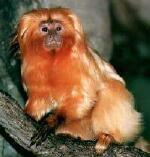|
|
|
[ Menu | Prosimians | New World Monkeys | Old World Monkeys | Gibbons & Great Apes ]
[ Primate Species Index ] [ Return to ZOOLOGY | Return to EVOLUTION ]
|
Karl von Linné (his Latinized name is Carolius Linnaeus) is today honored as the father of the binomial system of scientific nomenclature. Several Linnaean Societies celebrate his name and work to preserve the tradition he established. First, let's set a few definitions to aid in understanding the rest of this page:
Until about 100 years ago there was a great deal of confusion about the proper formal names of animals and plants. The situation was so chaotic that zoologists from around the world finally agreed to a set of rules for nomenclature, and vested authority for making decisions on disputed cases in an International Commission on Zoological Nomenclature. Botanists and other scientific groups now also have similar international commissions. In the listing below you will see mention of ICZN decisions affecting Linnaeus' names.
|
|
Linnaeus named 42 species of primates. In the counts given at right two of those names fit two categories, so you see 44 items given. Of those 42 names we only use two today exactly as Linnaeus presented them. Of his species still recognized today, all but two have been moved to new genera, one to a new order.
| 2 Linnaean Names Still in Full Usage |
| 29 Names; Transferred to New Genera | |
| 10 Names Entered into Synonymy | |
| 1 Transferred to Non-Primate Order | |
| 2 Searching for Info re: Disposition |
| Linnaean Name | Date | Now Known As: | Taxonomic Notes from Smithsonian Database. |
| Homo sapiens | 1758 | Homo sapiens | Linnaeus 1758 |
| Homo troglodytes | 1758 | Pan troglodytes | Simia troglodytes Blumenbach 1775.
Pan Oken 1816. ICZN 1988. Simia given as original name by Smithsonian. |
| Simia satyrus | 1760 | ||
| Simia satyrus | 1760 | Pongo pygmaeus | Pongo Lacépède 1799. |
| Prosimians | |||
| Lemur catta | 1758 | Lemur catta | Linnaeus 1758 |
| Lemur macaco | 1766 | Eulemer macaco | Eulemur Simons and Rumpler 1988. Type L. mongoz |
| Lemur mungoz | 1766 | Eulemur mongoz | |
| Lemur tardigradus | 1758 | Loris tardigradus | Loris É. Geoffroy 1796. Type Lemur tardigradus |
| Simia syrichta | 1758 | Tarsius syrichta | Tarsius Storr 1780 |
| New World Monkeys | |||
| Simia belzebul | 1766 | Alouatta belzebul | Alouatta Lacépède 1799. |
| Simia seniculus | 1766 | Alouatta seniculus | |
| Simia paniscus | 1758 | Ateles paniscus | Ateles É. Geoffroy 1806. Type S. paniscus L. 1758. |
| Simia jacchus | 1758 | Callithrix jacchus | Callithrix Erxleben 1777. Type. S. jacchus L. 1758. |
| Simia apella | 1758 | Cebus apella | Cebus Erxleben 1777 type = Simia capucina L. 1758 |
| Simia fatuellus | 1766 | ||
| Simia trepida | ? | ||
| Simia capucina | 1758 | Cebus capucinus | |
| Simia rosalia | 1766 | Leontopithecus rosalia | Leontopithecus Lesson 1840. L. makikina = S. rosalia |
| Simia pithecia | 1766 | Pithecia pithecia | Pithecia Desmarest 1804. Type S. pithecia L. 1766. |
| Simia midas | 1758 | Saguinas midas | Saguinas Hoffmannsegg 1807.
Saguinas ursula = Simia midas |
| Simia oedipus | 1758 | Saguinus oedipus | |
| Simia sciurea | 1758 | Saimiri sciureus | Saimiri Voigt, 1831. Type S. sciurea L. 1758 |
| Old World Monkeys | |||
| Simia cephus | 1758 | Cercopithecus cephus | C. Linnaeus 1758 (where?) Type S. diana L. 1758.
Designated a subgroup of Simia by Linnaeus. Simia suppressed by Opinion 114 of ICZN 1929. |
| Simia diana | 1758 | Cercopithecus diana | |
| Simia faunus | 1758 | ||
| Simia nictitans | 1766 | Cercopithecus nictitans | |
| Simia aethiops | 1766 | Chlorocebus aethiops | Chlorocebus Gray 1870. Type S. sabaea = S. aethiops |
| Simia sabaea | 1766 | Chlorocebus sabaeus | Seen by some taxonomists as a distinct species |
| Simia cynomolgos | ? | Macaca fascicularis | in The Pictorial Guide to the Living Primates |
| Simia nemestrina | 1766 | Macaca nemestrina | Macaca Lacépède 1799. Type S. inuus = S.sylvanus |
| Simia silenus | 1758 | Macaca silenus | |
| Simia veter | ? | ||
| Simia sylvanus | 1758 | Macaca sylvanus | |
| Simia inuus | 1766 | ||
| Simia sphynx | 1758 | Mandrillus sphinx | Mandrillus Ritgen 1824. Type S. maimon = S. sphinx |
| Simia maimon | 1766 | ||
| Simia hamadryas | 1758 | Papio hamadryas | Papio Erxleben 1777 = Cynocephalus Desmarest 1820 |
| Simia cynocephalus | 1758 | Papio cynocephalus | Seen by some taxonomists as a distinct species |
| Simia aygula | ? syn. | Presbytis comata | Desmarest 1822. Orig. name Semnopithecus comatus.
P. aygula is a nomen oblitum for Macaca fascicularis. No mention of Linnaeus found. |
| Simia apedia | ? | ? | No information yet regarding disposition of this name. |
| Simia morta | ? | ? | No information yet regarding disposition of this name. |
| Lemur volans | 1758 | Cynocephalus volans | Cynocephalus Boddaert 1768. Type L. volans L. 1758. (Flying Lemurs). Taxonomists now consider the Flying Lemurs closely related to the Primates but in their own Order Dermoptera. They are non-primate. |


